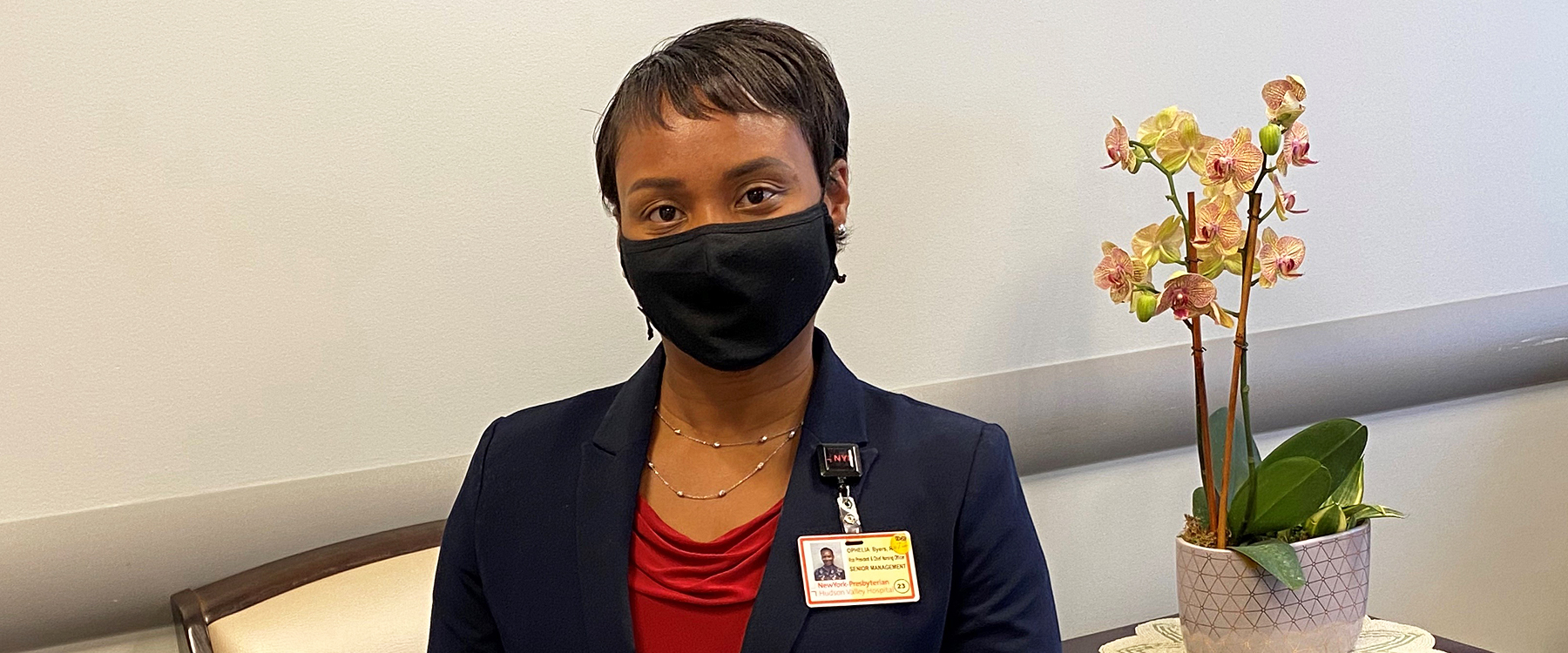My COVID-19 Story: Ophelia Byers
The vice president of Patient Care Services and chief nursing officer reflects on NewYork-Presbyterian Hudson Valley Hospital’s response to the COVID-19 crisis.

Six months after becoming the vice president of Patient Care Services and chief nursing officer at NewYork-Presbyterian Hudson Valley Hospital, Ophelia Byers led her team through the unprecedented COVID-19 pandemic, and “we came through smarter, wiser, stronger.”
In the age of social media, various “challenges” have gone viral—from 2014’s “Ice Bucket Challenge” on Facebook to 2020’s “Don’t Rush Challenge” on TikTok. During the COVID-19 crisis at NewYork-Presbyterian Hudson Valley Hospital (NYP HVH), it is the “Anyway Challenge” that best captured our experience and spirit.
In 1968, Dr. Kent Keith, then a 19-year-old sophomore at Harvard College, wrote and published a book for student leaders. The guide included what he called “The Paradoxical Commandments.” Over time, these commandments have been shared around the world, urging readers to do the right thing, no matter what. From the original writ (which can be read in full here) sprang forth the “Anyway Challenge”—a shortened version wherein the directives to drive on in adversity become pledges to persevere:
“I will love people anyway, do good anyway, succeed anyway, be honest and frank anyway, fight for a few underdogs anyway, build anyway, help people anyway, and give the world the best I have anyway. I will face the worst in the world with the best of myself.”
As a nurse executive during the heart-rending peak of the COVID-19 pandemic, I witnessed the inter-professional, cross-departmental team at NYP HVH unwittingly accept and meet the “Anyway Challenge.” At every level of our small-but-mighty community hospital—from the basement to the fourth floor, from the bedside to the boardroom—our team remained steadfast in our NewYork-Presbyterian guiding principle: “We put patients first.” Like other sites in the NYP enterprise, and hospitals all over the world, NYP HVH expanded bed capacity and role responsibilities beyond our imaginations. We conserved personal protective equipment and exhausted ourselves with extra shifts and frequent leader rounding to check-in with the team. We spilled tears, yet bottled our fears, because we insisted on being brave for our patients, their families, and each other. Here are a few “Anyway” anecdotes:
With the stoppage of elective surgeries, the Perioperative Services team of nurses and surgical, endoscopy, and Central Sterile Processing (CSP) technicians were redeployed to other areas. They had to change their environments, their schedules, their skills, and their lives. They went forward to new locations with trepidation about what they would meet there; but they went forward—anyway. They spent almost three months away from their originally assigned areas in Perioperative Services. Nurses and surgical technicians worked in the Emergency Department, Intensive Care Unit, and all units in between. CSP technicians worked in Environmental Services and Materials Management. One operating room nurse was resolute that she would be of maximum support to the Medical-Surgical units. With committed preceptors, she rigorously trained; and in less than four weeks, she independently assumed full patient assignments!
As time passed in the pandemic, it became clear to nurse leaders that the group festivities traditionally held during National Nurses’ Week could not occur this May. We had to remain physically distanced; but we had to celebrate our phenomenal Nursing staff—anyway. We quickly gathered ideas from staff, physicians, and senior leaders and planned simple, creative activities that focused on self-care, cross-unit and hospital-wide appreciation, and charitable giving. Many nurses from various units commented, “This was our best nurses’ week ever because it was all about recognition and our respect for each other.”
Now that the COVID curve has flattened, we have time to reflect on the crisis. It was a relatively brief moment in time, yet an eternity. In a contemplative moment of great esteem and appreciation, a Medical-Surgical nurse shared a beautiful recollection. Weeks before, at the apex of the crisis at NYP HVH, she was at an emotional breaking point. The acuity of the COVID-positive patients and the many deaths seemed too much to bear. One day, during rounds, a senior leader stopped to speak with this nurse. While the nurse was despondent and wanted to withdraw, she spent time speaking with the senior leader—anyway. Recounting her experience, she said, “I didn’t tell him how bad I was feeling. Still, he was so positive and kind. I felt hopeful again. He saved my life that day.”

The 4 South Medical-Surgical team at NYP Hudson Valley Hospital
There are many amazing stories to share about the NYP HVH team during the COVID-19 crisis. Our brave Emergency Department remained steadfast as the gateway to our hospital. The ICU team remained focused and determined despite devastating losses. Though undoubtedly exhausted, the Respiratory Therapy team worked tirelessly to manage ventilator volumes six times our normal. The Progressive Care Unit nurses and Patient Care technicians—with the real-time, on-the-spot education from their nurse leader and educators—quickly learned to care for ventilated patients. Proud of their newfound capabilities, they posted a colorful sign that reads, “Progressive Care Unit, also known as ICU 2.0.”
I have been with NYP for eight years; and in September 2019, I joined NYP HVH as the vice president of Patient Care Services and chief nursing officer. Six months into my new role at a new site, a pandemic hit and rocked our foundation. Admittedly, I was scared, worried, and uncertain almost daily; but my commitment to the high-quality care of my team as well as our patients—and the inspiring courage, resilience, and service excellence of the whole NYP HVH family—fueled me daily. Inarguably, this was the most difficult and demanding time in our respective healthcare careers, but NYP HVH team endured the height of the COVID-19 crisis. We came through smarter, wiser, stronger, and more cohesive than ever before. We did it—anyway!
